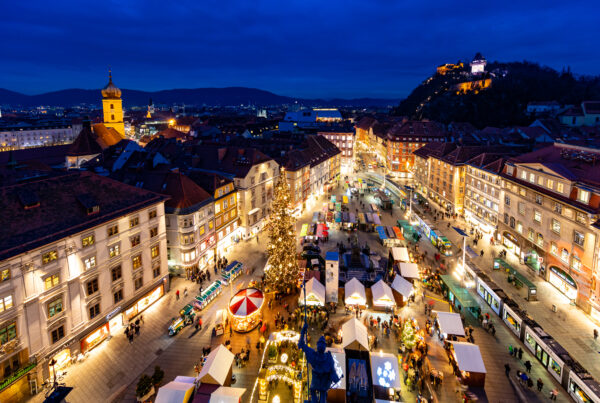The beginning of Advent, four weeks before Christmas, marks the start of Germany’s Christmas market season. In cities, towns and villages, not to mention scenic locations such as castles and forests, rows of wooden huts are strung with twinkling lights, offering handmade gifts and souvenirs, German Christmas market foods and drinks, and the opportunity for locals and visitors to gather together and enjoy some festive cheer.
Grilled sausages, roast chestnuts and candied almonds are amongst Germany’s best known Christmas market culinary staples, but there are also countless regional specialties to be sought out. The likes of Aachener Printen and Alsatian Flammkuchen may now be popular beyond their places of origin, but there’s nothing like sampling food or drink at its source. Here are five festive regional specialties to try if you get the chance.
Stollen, Dresden
Dresden’s famous Stollen is a yeasted fruit bread made with butter, almonds, candied citrus peel, as well as spices. It plays such an important role in the city’s history that it is celebrated with its own annual festival. As a product with EU Protected Geographical Indication, it’s only made in selected bakeries in and around Dresden. The recipe is set out by the Dresden Stollen Association. Watch a giant loaf being paraded through the streets at the festival before trying a slice at the Christmas Bakery and Showroom Bakery at the Striezelmarkt, one of Germany’s oldest Christmas markets.

Winzerglühwein, Germany’s wine regions
A steaming hot drink is an essential part of any Christmas market visit. Glühwein (mulled wine) is arguably the most popular option. However as a mass-produced drink, it’s made with low quality wine whose flavour is masked with vast quantities of sugar. A high quality alternative, known as Winzerglühwein (“vintner’s mulled wine”), can be found in Germany’s winegrowing regions. Produced by individual winemakers on their own wineries, it’s made with base wine from their own grapes. It’s sweetened to taste with natural sugars and seasoned, often to a family recipe, with whole spices. The Christmas markets in Mainz and Wiesbaden, in the Rheinhessen and Rhengau wine regions respectively, both have Winzerglühwein stands.

Bethmännchen, Frankfurt
Bethmännchen are bite-sized marzipan pastries named after the von Bethmanns, a family in Frankfurt. They are said to have first been made for the family by French confectioner Jean Jacques Gautenier in 1838. Made with flour, icing sugar, marzipan and eggs and flavoured with rose water, Bethmännchen were originally decorated with four halved, skinned almonds to represent the von Bethmann’s four sons. After one of them died, an almond was removed, and today they are still only decorated with three. Pair a Bethmännchen with another Frankfurt festive classic, a glass of Heißer Apfelwein (mulled local cider) at one of the city’s sprawling Christmas markets.

“Bethmännchen”, a typical Frankfurt delicacy made of marzipan and almonds. Photo credit: visitfrankfurt_Holger Ullmann
Marzipan, Lübeck
The world famous marzipan produced in the north German city of Lübeck was first documented in 1530. The city became well known for its high quality marzipan in the 18th century thanks to the high percentage of raw almonds used in its production. Today, as a product with EU Protected Geographical Indication status, Lübeck marzipan is made by only a handful of manufacturers in and around Lübeck. Try it at one of the city’s very pretty Christmas markets, perhaps in chocolate-covered loaf form or as a liqueur.

Marzipan from Lübeck Photo credit: © LTM
Schmätzchen, Coburg
Coburger Schmätzchen, known in local dialect as “Schmätzle”, roughly translating as “little kiss”, are a specialty of Coburg, a town known for its lengthy Lebkuchen-making history. Formed from an aged honey and wheat dough studded with almond and hazelnut pieces, candied lemon and orange peel and spices, the firm little biscuits were developed in the 1800s by local master baker Wilhelm Feyler. Now in its fourth generation, the Feyler patisserie and Lebkuchen manufacturer continues to produce them today. They also offer a version dipped in dark chocolate and decorated with gold leaf. Delicious with a cup of coffee at Coburg’s Christmas market, considered one of southern Germany’s prettiest.

Coburger Schmätzchen Photo credit: erlebe.bayern – Thomas Linkel
Christie Dietz is an award-winning food and travel writer from the UK, who moved to Germany in 2010. A regular contributor to National Geographic Traveller Food magazine, she also has bylines in publications including Food and Travel, Gastro Obscura and The Guardian. Website | Blog






